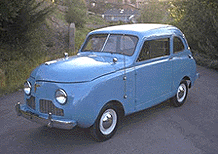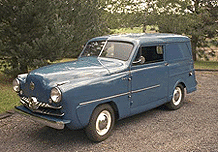1946-1952 History
 During the war, Crosley developed the overhead cam four-cylinder Cobra engine for a U.S. Navy project, using a block of brazed copper and sheet steel. This engine was selected to power postwar cars. It displaced 44 cubic inches (2.50 x 2.25-inch bore and sroke), developed 26.5 hp at 5400 rpm, and weighed only about 60 pounds. This five-main-bearing engine had been fairly sucessful during the war in powering a variety of machines from truck refridgerators to Mooney Mite airplanes. It was less useful in automotive applications. The copper-steel block was subject to electrolysis, which caused holes to develop in cylinders and resulted in early rebuilts. Crosley finally recognized the fault by changing to a cast-iron block in 1949.
The original dimensions were retained. (Significantly, used car price guides gave a higher-resale value for cast-iron-block models, including the 1946-1948 Crosleys that had been retrofitted with the new engines.)
During the war, Crosley developed the overhead cam four-cylinder Cobra engine for a U.S. Navy project, using a block of brazed copper and sheet steel. This engine was selected to power postwar cars. It displaced 44 cubic inches (2.50 x 2.25-inch bore and sroke), developed 26.5 hp at 5400 rpm, and weighed only about 60 pounds. This five-main-bearing engine had been fairly sucessful during the war in powering a variety of machines from truck refridgerators to Mooney Mite airplanes. It was less useful in automotive applications. The copper-steel block was subject to electrolysis, which caused holes to develop in cylinders and resulted in early rebuilts. Crosley finally recognized the fault by changing to a cast-iron block in 1949.
The original dimensions were retained. (Significantly, used car price guides gave a higher-resale value for cast-iron-block models, including the 1946-1948 Crosleys that had been retrofitted with the new engines.)
The 1946 Crosley first appeared as a two-ddor, four seat sedan priced at $905. Production began in june 1946. A dozen 1946 convertibles were built. In 1947,
a two-door convertible was added at $949; the sedan price dropped to $888.
A station wagon priced at $929 and a "sport utility" model priced at $799
were added by 1948. Sedan and convertible prices were cut again to spark sales. Commercial bodies were also offered, and in this period the future looked bright.
After building almost 5000 cars in model year 1946, Crosley went on to produce 19,000 of the 1947 models and 29,000 of the 1948s. But this marked the end of prosperity. New designs from the big Three, innovative new cars from the independants, and Crosley's growing reputation for engine problems combined to lower production to just 7431 units for the model year 1949.
 The sales slide was ironic in that Crosley had become a much better car by 1949 than it ever had been before. New styling was introduced: integral fenders, a smooth hood carrying sealed-beam headlights in upright pods, and turn indicators on sedans and convertibles.
In addition to the 80-inch wheelbase for sedan, delivery, convertible and station wagon models, Crosley fielded an 85-inch wheelbase for the new Hotshot roadster. No Crosley exceeded $900 in price:
smaller models ranged from $866 to $894. The Hotshot cost only $849.
The sales slide was ironic in that Crosley had become a much better car by 1949 than it ever had been before. New styling was introduced: integral fenders, a smooth hood carrying sealed-beam headlights in upright pods, and turn indicators on sedans and convertibles.
In addition to the 80-inch wheelbase for sedan, delivery, convertible and station wagon models, Crosley fielded an 85-inch wheelbase for the new Hotshot roadster. No Crosley exceeded $900 in price:
smaller models ranged from $866 to $894. The Hotshot cost only $849.
In 1951, the Hotshot would prove its mettle at the Sebring Twelve Hours, winning the Index of Performance. Even in non-race tune, the little roadster could do about 90 miles an hour. Its handling,
thanks to a semi-elliptical-spring front suspension and coil springs with quarter eliptics at the rear, was outstanding. See what Motor Trend had to say about the Super-Sport in this 1951 Road Test. Or, click here for the Crofton Story.
Photo Credit: CC coupe and CD panel
delivery owned by Jim & Jo Hockenhull
 Main Page
Main Page
 During the war, Crosley developed the overhead cam four-cylinder Cobra engine for a U.S. Navy project, using a block of brazed copper and sheet steel. This engine was selected to power postwar cars. It displaced 44 cubic inches (2.50 x 2.25-inch bore and sroke), developed 26.5 hp at 5400 rpm, and weighed only about 60 pounds. This five-main-bearing engine had been fairly sucessful during the war in powering a variety of machines from truck refridgerators to Mooney Mite airplanes. It was less useful in automotive applications. The copper-steel block was subject to electrolysis, which caused holes to develop in cylinders and resulted in early rebuilts. Crosley finally recognized the fault by changing to a cast-iron block in 1949.
The original dimensions were retained. (Significantly, used car price guides gave a higher-resale value for cast-iron-block models, including the 1946-1948 Crosleys that had been retrofitted with the new engines.)
During the war, Crosley developed the overhead cam four-cylinder Cobra engine for a U.S. Navy project, using a block of brazed copper and sheet steel. This engine was selected to power postwar cars. It displaced 44 cubic inches (2.50 x 2.25-inch bore and sroke), developed 26.5 hp at 5400 rpm, and weighed only about 60 pounds. This five-main-bearing engine had been fairly sucessful during the war in powering a variety of machines from truck refridgerators to Mooney Mite airplanes. It was less useful in automotive applications. The copper-steel block was subject to electrolysis, which caused holes to develop in cylinders and resulted in early rebuilts. Crosley finally recognized the fault by changing to a cast-iron block in 1949.
The original dimensions were retained. (Significantly, used car price guides gave a higher-resale value for cast-iron-block models, including the 1946-1948 Crosleys that had been retrofitted with the new engines.)
 The sales slide was ironic in that Crosley had become a much better car by 1949 than it ever had been before. New styling was introduced: integral fenders, a smooth hood carrying sealed-beam headlights in upright pods, and turn indicators on sedans and convertibles.
In addition to the 80-inch wheelbase for sedan, delivery, convertible and station wagon models, Crosley fielded an 85-inch wheelbase for the new Hotshot roadster. No Crosley exceeded $900 in price:
smaller models ranged from $866 to $894. The Hotshot cost only $849.
The sales slide was ironic in that Crosley had become a much better car by 1949 than it ever had been before. New styling was introduced: integral fenders, a smooth hood carrying sealed-beam headlights in upright pods, and turn indicators on sedans and convertibles.
In addition to the 80-inch wheelbase for sedan, delivery, convertible and station wagon models, Crosley fielded an 85-inch wheelbase for the new Hotshot roadster. No Crosley exceeded $900 in price:
smaller models ranged from $866 to $894. The Hotshot cost only $849.